

1 & Punc t uation Spelling, G rammar, Teach e r ’s Book
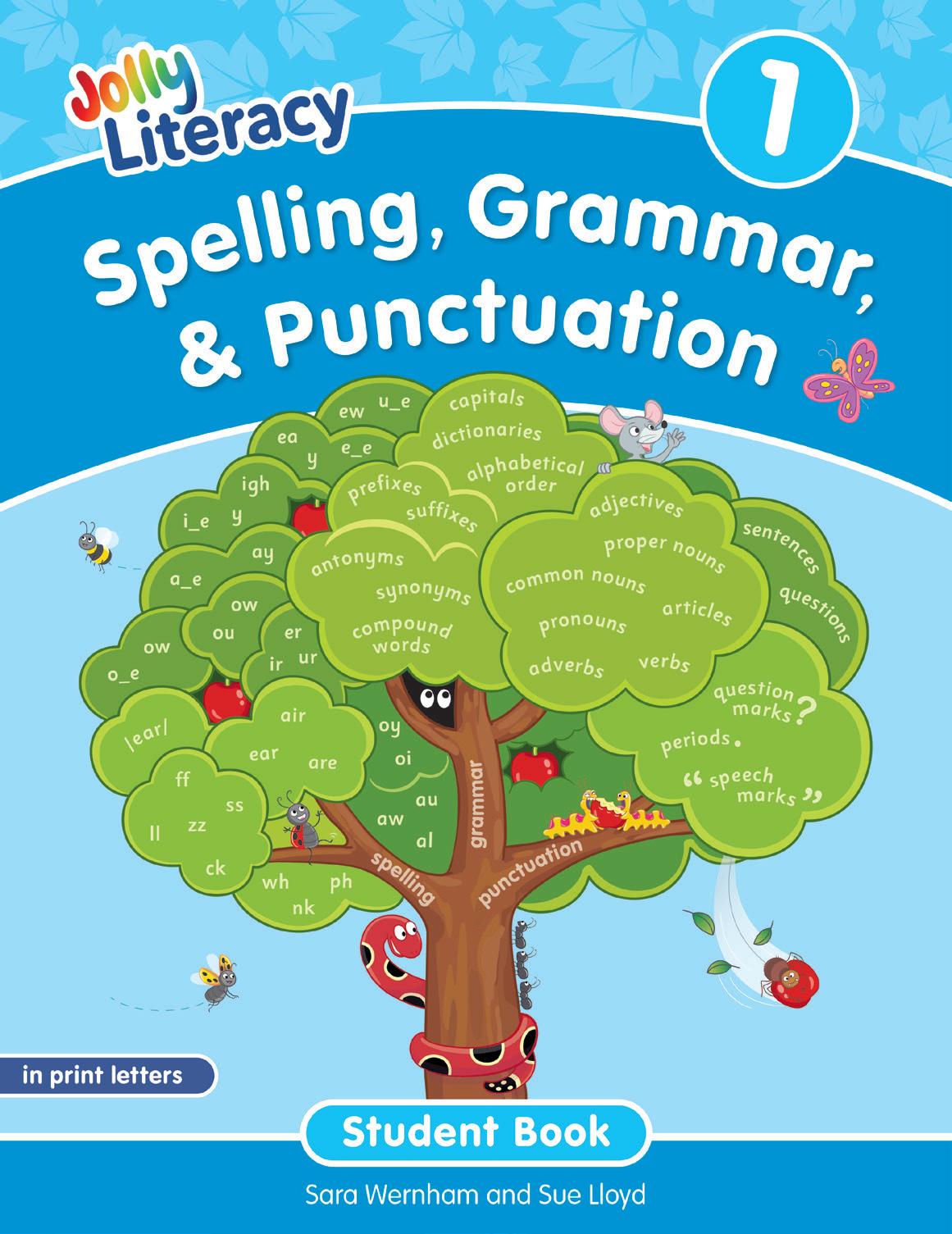
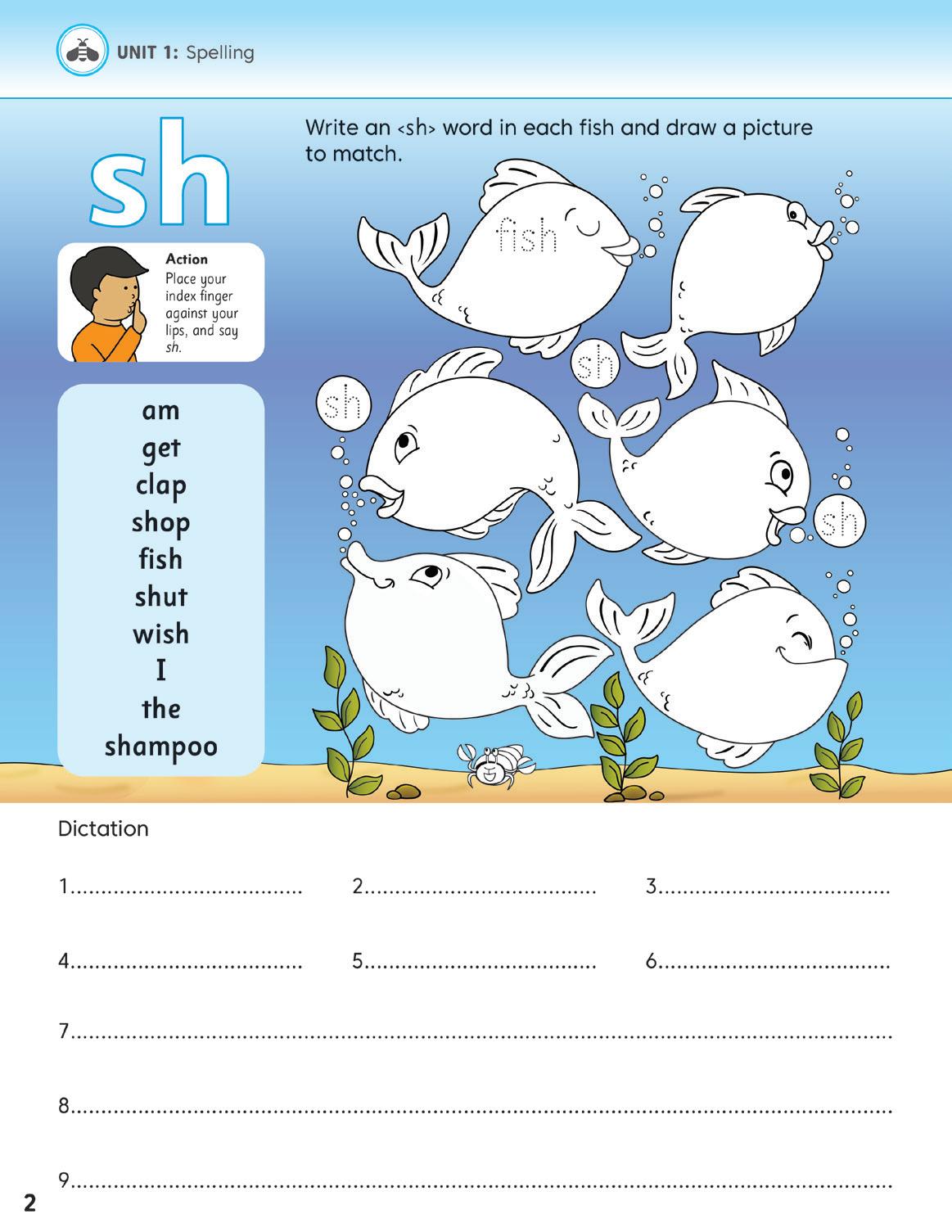
Sara Wernham and Sue Lloyd
Formerly Teache r’s Book
A brief overview of the program
What is Spelling, Grammar, & Punctuation?
Spelling, Grammar, & Punctuation (formerly Jolly Grammar) is part of Jolly Literacy and sits alongside the new Reading Comprehension & Writing Skills program. Its systematic and cumulative syllabus enables students to spell and punctuate more accurately, use a wider vocabulary, and have a clearer understanding of how language works. Its structured approach is suited to wholeschool, whole-class teaching but it also works well with individual students.
Why is learning spelling, grammar, and punctuation important?
The most dramatic improvements to result from using the Spelling, Grammar, & Punctuation program will be found in the students’ writing. In their first year at school, Jolly Phonics teaches the students to write independently by listening for the sounds in words and writing the letters that represent those sounds. This skill enables the students to write pages of news and stories, and it is a joy to read their work and to see the pride and confidence they derive from their newly acquired skills.
Spelling, Grammar, & Punctuation builds on this foundation over the next six years, with a carefully planned syllabus designed to develop the students’ writing skills. Gradually, the students become aware that they are writing for a purpose: that their words are intended to be read and understood. They learn that their writing is easier to understand if it is grammatically correct, accurately spelled and punctuated, well organized, and neatly written. The students also learn that if they use interesting words, their writing can give real pleasure. Even in the early stages, it is valuable for students to have a simple understanding of this long-term goal.
Spelling, Grammar, & Punctuation and the science of reading
The science of reading is a term that encapsulates all the evidence-aligned research compiled
over the last 50 years, which shows us how students master reading and writing skills. Linguists, cognitive psychologists, neuroscientists and other specialists across many nations, languages, and disciplines have concluded that to create competent readers and writers, we must understand how reading develops in the brain and teach and assess our students accordingly. One such study by The National Reading Panel (Teaching Students to Read, April 2000), analyzed hundreds of research studies and reached a consensus that, for the best results, students need explicit instruction in phonemic awareness and systematic phonics teaching, with a focus on improving fluency, vocabulary acquisition, and reading comprehension.
A key aim of Spelling, Grammar, & Punctuation is to improve students’ fluency, vocabulary acquisition, and reading comprehension. The primary way it does this is to build upon the explicit instruction in phonemic awareness and phonics teaching first introduced for reading and writing in Jolly Phonics. With secure letter-sound knowledge and the ability to recognize different spellings for those sounds, the students greatly increase the number of words they can blend and segment automatically. Mastery of these skills leaves more working memory available to tackle the many demands of reading comprehension. A secondary but equally important element of the program’s systematic teaching of grammar and punctuation is that it significantly increases the students’ awareness of sentence structure (syntactic awareness). This ability has been proven to improve students’ writing skills and enhance their reading comprehension.
The science of writing
Although not as extensively researched over the years as the science of reading, the body of research is substantial and indicates that writing instruction is most effective when it is taught systematically, alongside reading. The success of Jolly Phonics and the Spelling, Grammar, & Punctuation program supports these findings. From the start, students learn to blend words for reading and segment words for writing. They are
What is Jolly Literacy?
Jolly Literacy builds on the teaching of Jolly Phonics, a multisensory and active program that aims to teach young students to read and write by applying the English alphabetic code and the five key skills: 1. Learning the letter sounds; 2. Learning letter formation; 3. Blending (for reading); 4. Identifying the sounds in words (for writing); 5. Tricky words. Following on from Jolly Phonics, Jolly Literacy will offer two, six-level programs that work together seamlessly to give students the skills they need to become confident readers and enthusiastic writers.
Spelling, Grammar, & Punctuation provides two lessons a week. It teaches new spelling patterns, dictionary and thesaurus skills, an understanding of sentence structure, and complex grammatical concepts in an engaging and child-friendly way.
Reading Comprehension & Writing Skills provides two further weekly lessons. In the first, the students explore, read, and analyze a variety of rich, interesting texts that reinforce and utilize the spelling and vocabulary that have been recently taught. The second lesson uses those texts as a springboard for stimulating ideas that not only promote creative, imaginative, and independent writing, but also reflect and employ the grammar and punctuation they have learned. This leaves a day free for teachers to focus on other literacy work, such
also given explicit direction and practice in letter formation, first for the lower-case letters and digraphs, and then for the capital letters. Then, as the students progress, they are taught to write phrases and sentences in scaffolded and independent writing, as well as dictation.
The students continue to improve their writing in the following years, with a focus on building phonic knowledge, widening vocabulary, refining spelling, learning grammatical concepts, and developing a greater understanding of sentence structure.
as group and individual reading or handwriting practice. It is important to show the students how their spelling and grammar work relates to these areas. For instance, if they have recently learned about compound words and there is an example of one in the poem they are reading, the students should be encouraged to look for it.
Jolly Literacy and TEFL
Teaching both programs across the week enables students to develop effective communication skills, helping them express themselves accurately and confidently in English. This is a lifelong skill and is necessary for students to develop intellectually, socially, emotionally, culturally, and spiritually.
The focus of Jolly Literacy progressively develops writing and comprehension skills, which are the foundation for the English level exams and provides additional opportunities to practice speaking and using vocabulary and language structures.
Together, the programs offer a complete foundation for English language learning, using topics and themes that allow for vocabulary acquisition as well as scaffolding more complex concepts of English that are introduced in later levels.
What is in the program?
Spelling, Grammar, & Punctuation is a complete, structured program with six levels for students aged 5 to 11. Each level has the following:
• 36 weekly units, with two lessons per unit – one on spelling, the other on grammar, spelling, punctuation, vocabulary development, or alphabet and dictionary work
• lessons that are an hour long, dependent on usage, with the flexibility to be used in different ways in a variety of settings
Teaching the spelling lessons
1. Flashcard review
Start every lesson with a short review session, focusing on the spelling patterns and tricky words taught in Jolly Phonics (for reading) and revisited in Level 1 (for spelling). The sessions are divided into six-unit blocks and cover the content of those units. So in Units 1 to 6, for example, the original digraphs and first 12 tricky words are reviewed. The next block focuses on the short and long vowels, double letters, alternative spellings of the /air/ sound, and the next set of tricky words. If a new sound or spelling pattern is introduced in a block, such as the ‹ear› spelling for /ir/, it is reviewed in the following week. The details of what to review are provided in the lesson plan for each unit.
2. Spelling focus
Most of the spelling lessons focus on one of the alternative spellings taught for reading in Jolly Phonics. Begin by asking groups of two or three students to think of words that contain this spelling pattern. Asking them to share their ideas in this way maximizes class engagement. These words can then be written on the board for the students to sound out and blend. It is a good idea to prepare a list of regular words to supplement the students’ suggestions. The Jolly Phonics Word Bank has lots of good examples. Encourage the same pairs or trios to make up sentences using some of the words on the board. Students are more likely to remember new words if they use them in context, and orally rehearsing sentences will help them compose one of their own in the extension activity. Later, the words could be made into a wall display, by writing, for example, the ‹sh› words in a large fish shape.
3. Spelling list and weekly test
Every week the students are given ten spelling words to learn for a test. It is best to set the spelling homework at the beginning of the week and to test the students at the end of the week, or on the following Monday. Introduce the words during the lesson and revisit them as frequently as possible throughout the week, ideally daily. The class
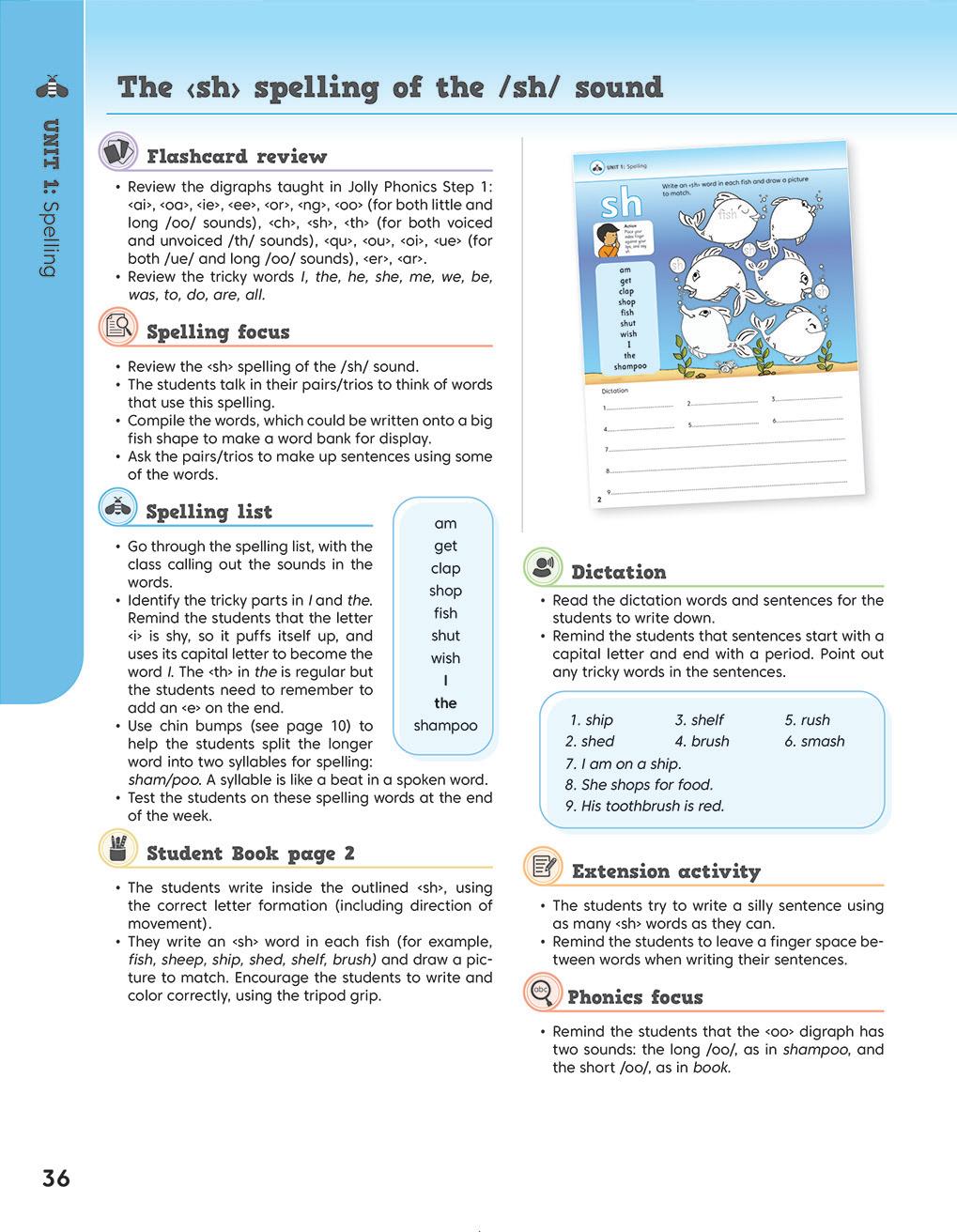
can work in pairs or trios to do this, testing each other on their spelling homework.
During the lesson, work through the words with the students. Call out the sounds in the regular words and encourage the students to hold up a finger for each sound. Then help them to identify the tricky parts in the tricky words. They can also use chin bumps to break the longer word down into syllables (see page 10) or – if it is a compound word – they can split it into the two shorter words. The spelling words have been carefully chosen to ensure all the students have some success, with most achieving a perfect score:
• Words one and two are regular two- or three-letter words. Word three is also regular, but with a consonant blend.
• All the students should be able to spell the first three words correctly by listening for the sounds.
• Words four, five, six, seven, and ten feature the weekly spelling pattern and are usually regular. Word ten is a longer, more challenging word.
• Words eight and nine are tricky words. If any students need extra practice writing them, they can use the tricky word spelling routine (see page 13).
Additionally, students who find spelling very challenging can be given fewer words, as long as the words contain that week’s spelling pattern. The students should take their spelling words home to learn. If the Student Books are typically left at school, the words can be sent home in a small homework book. Parental support is extremely valuable, particularly when parents encourage their child to segment the regular words and identify the tricky parts in tricky words.
Test and grade the spelling words each week. There are six pages (pages 74 to 79) at the back of the Student Book for spelling tests. During the test, ask the students to turn to the back of their books and find the designated space for that week’s test. Call out the words one at a time, repeating each word twice. Give the students just enough time to write it out before moving on to the next. While the words can be called out in the list order, using a random order is preferred. The results can be recorded in either the Student Books or homework books. Grades can be shown as a score out of ten or given using a coded star system (gold for 10/10, silver for 9/10 and a colored star for 8/10). Most parents appreciate being involved in their child’s homework and are interested in seeing how many words were spelled correctly and which words were misspelled.
4. Student Book page
The students write inside the outlined spelling pattern at the top of the page, using the correct direction of movement. They then choose a word to write in each shape, or fill in the missing letters in the words provided, and draw a picture to match. The students can either use some of the words on the board, or think of some of their own. Always encourage the students to be accurate in their work and to write and color in correctly, using the tripod grip. The lines at the bottom of the page are for the weekly dictation. This can be given during the lesson or done at a different time during the week.
5. Dictation
Weekly dictation offers numerous benefits to students. It provides regular segmenting practice, which is an essentiall skill for writing, and allows teachers to monitor their progress. Dictation also gives students the opportunity to write the tricky words in context and use basic punctuation correctly. This develops their independent writing skills and encourages slower writers to increase their speed.
The weekly dictation consists of six words and three simple sentences. While the primary focus is on the weekly spelling pattern, the sentences also incorporate previous spelling patterns and the tricky words. Begin by calling out the first word and ask the students to write it down in their Student Books. When they have finished, ask a student to sound out the word. As each sound is said, write the letter(s) on the board and – when the target sound is reached – ask the student how it is spelled. The other students check whether they have written the word correctly and, if so, mark it with a check. Dictate the remaining words and sentences, pointing out any tricky words. Remind the students to begin each sentence with a capital letter, end with a period, and leave a finger space between each word. If there is time at the end, check the other students’ work.
Initially, dictation may be slow, and it might be necessary to reduce the number of words and sentences. However, the ultimate goal is for the students to write accurately and quickly from dictation. When most of the students have written a word or sentence, encourage everyone to move on to the next, even if some have not finished. This will encourage those students who need extra practice to get up to speed. These students can also be given additional words for dictation homework.
Without regular practice, some students may lose the ability to hear the sounds in words, especially those students who were slower to develop phonemic awareness initially. This will become evident in the students’ independent writing. For example, if students write play as “paly,” this means they need to practice listening more carefully to the sounds in words.
The ‹qu› spelling of the /qu/ sound
Flashcard review
• Review the digraphs taught in Jolly Phonics Step 1: ‹ai›, ‹oa›, ‹ie›, ‹ee›, ‹or›, ‹ng›, ‹oo› (for both little and long /oo/ sounds), ‹ch›, ‹sh›, ‹th› (for both voiced and unvoiced /th/ sounds), ‹qu›, ‹ou›, ‹oi›, ‹ue› (for both /ue/ and long /oo/ sounds), ‹er›, ‹ar›.
• Review the tricky words I, the, he, she, me, we, be, was, to, do, are, all
Spelling focus
• Review the ‹qu› spelling of the /qu/ sound. Remind the students that ‹qu› is made up of two sounds: /k/ and /w/. If the students hear /kw/ in an English word, the correct spelling is almost always ‹qu›. However, in some names, especially those of African origin, the correct spelling is ‹kw›, as in Kwame
• The students talk in their pairs/trios to think of words that use the ‹qu› spelling.
• Compile the words, which could be written onto a big duck shape to make a word bank for display.
• Ask the pairs/trios to make up sentences using some of the words.
Spelling list
• Go through the spelling list, with the class calling out the sounds in the words.
• Identify the tricky parts in to and do. At the end of both these words, the long /oo/ sound is written with only one ‹o›.
• Use chin bumps (see page 10) to help the students split the longer word into two syllables for spelling: squir/rel.
• Test the students on these spelling words at the end of the week.
Student Book page 10
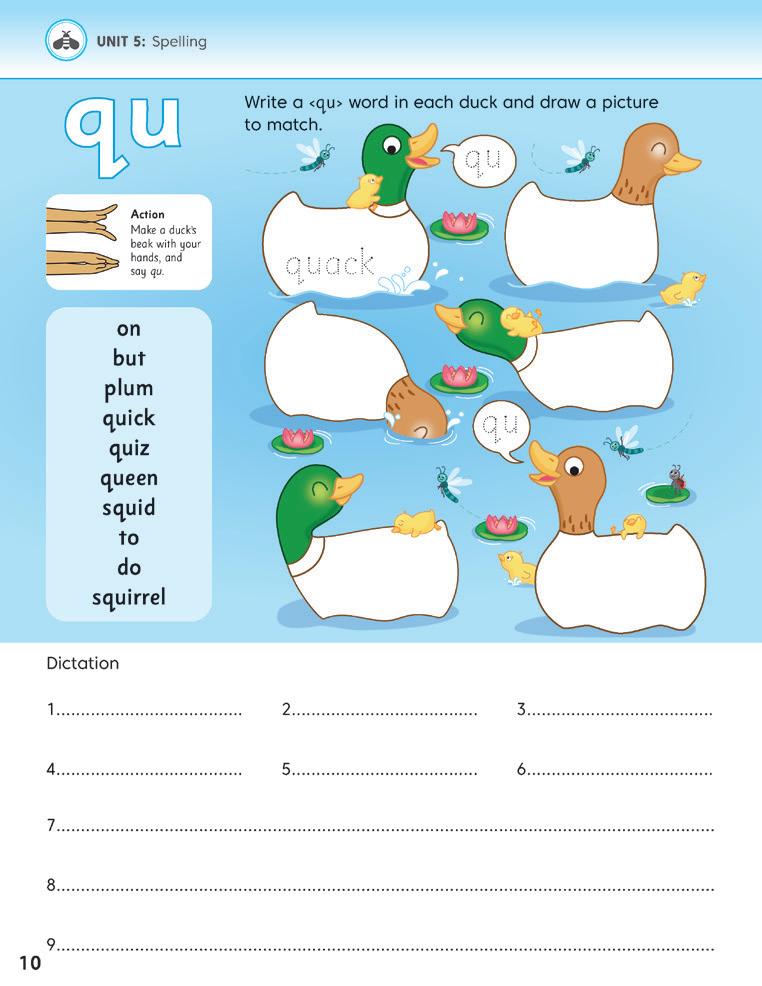
Dictation
• Read the dictation words and sentences for the students to write down.
9. That quiz was hard. on but plum quick quiz queen squid to do squirrel
• The students write inside the outlined ‹qu›, using the correct letter formation (including direction of movement).
• They write a ‹qu› word in each duck (for example, quack, queen, quail, liquid, quick, squid) and draw a picture to match. Encourage the students to write and color correctly, using the tripod grip.
• Remind the students that sentences start with a capital letter and end with a period. Point out any tricky words in the sentences.
1. quit 2. quick 3. quench 4. quail 5. quest 6. liquid
7. She is a quick thinker.
8. The ducks quack at the fish.
Extension activity
• The students try to write a silly sentence using as many ‹qu› words as they can.
• Remind the students to leave a finger space between words when writing their sentences.
abc
Phonics focus
• Usually, when you hear the sounds /k/ and /w/ together in an English word it is spelled ‹qu›. However there are exceptions: names, such as Kwame, and brand names, such as Kwik Fit.
Proper nouns
Learning objective
• Develop the students’ understanding that there are different types of words, and that each type has a special name. Proper nouns are the names given to particular people and places, and to months and days of the week.
Introduction
• The students practice saying the alphabet.
• Write or hold up capital letters and ask the students to say the name and/or sound for each.
• Ask some of the students to write their name on the board. Check that they have all started their names with capital letters.
• Ask the students what all the names on the board have in common. The answer is that they all start with a capital letter.
• Show the students some names in a story book. Point out that all the names start with a capital letter. Explain that people’s names always start with a capital letter.
Grammar focus
• Special names that are given to people, places, or things are called Proper Nouns. The students’ names are proper nouns. They have a capital letter to show how important they are. Other names are special, too, and they also need a capital letter: for example, the name of a school, road, town, or country.
• The school’s address could be written out on the board, or on a big piece of paper or envelope, to be read with the students so that they can identify the proper nouns. The proper nouns should all have capital letters.
• Introduce the action and color for proper nouns. The action for proper nouns is to touch your forehead with your index and middle fingers. The color for nouns is black. (If using a chalkboard, explain that as there is no black chalk, white chalk is used instead.)
Student Book page 11
• The students write in the outlined words Proper nouns, using a black pencil.
• Then they draw a picture of themselves in the first frame and write their name underneath, remembering to use a capital letter. There is a line for their last name as well.
• The students write the name of their teacher under the second frame and draw a picture in it.
• Then they write the school address on the picture of the envelope. (The students are correct as long as they have written appropriate answers with capital letters at the beginning of each proper noun.)
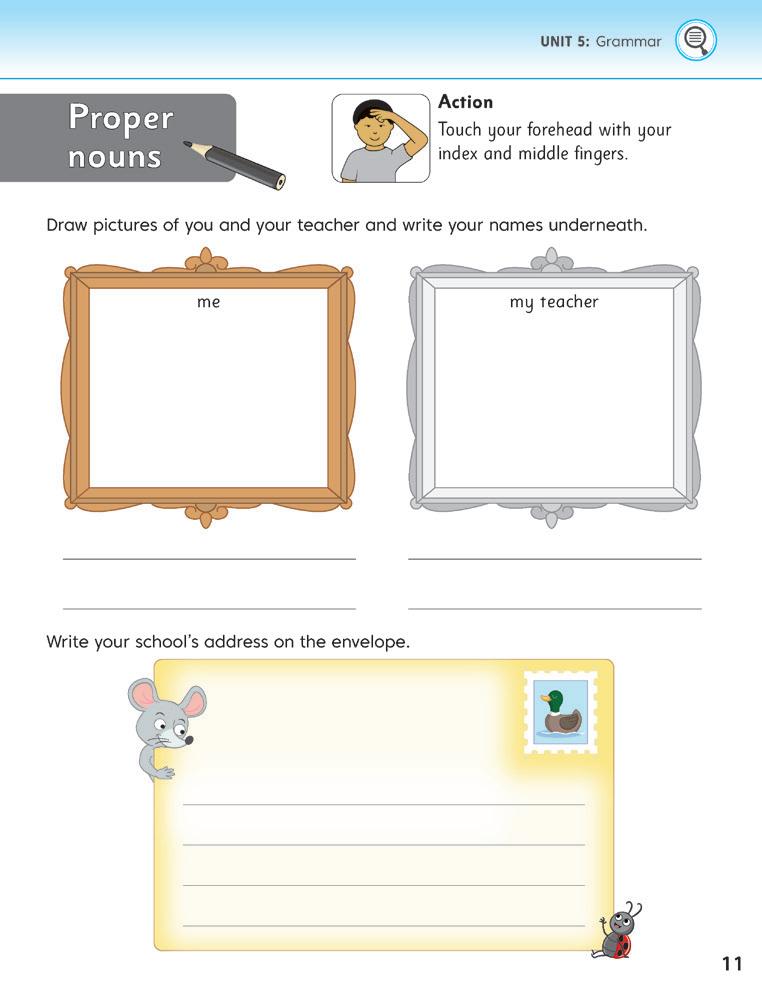
Extension activity
• The students write the names of others at their table or in their class.
• They could also look for proper nouns in storybooks, and for the names of towns, cities, and countries in their atlases.
Plenary
• Call out some words, including some proper nouns. When the students hear a proper noun, they do the action. When they do not, they keep still.
Action: The action for a proper noun is to touch your forehead with your index and middle fingers.
Color: The color for all types of noun is black.
Ages 5+
Spelling, Grammar, & Punctuation is a six-level program that gives young students the skills they need to be confident readers and enthusiastic writers. It builds on the teaching in Jolly Phonics and has the same multisensory, active, and fun approach. The systematic and cumulative syllabus enables students to spell and punctuate more accurately, use a wider vocabulary, and have a clearer understanding of how language works.
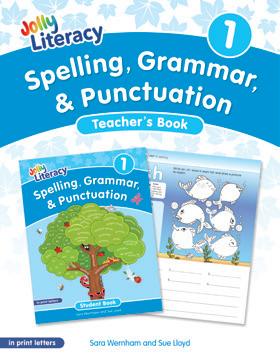
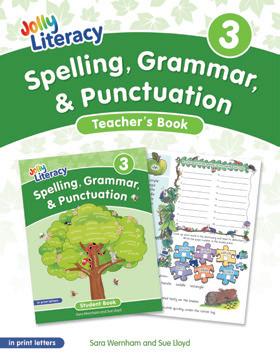
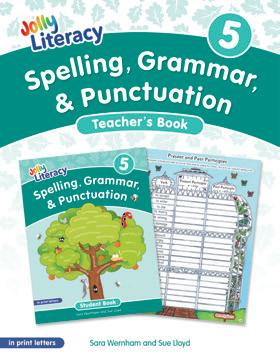
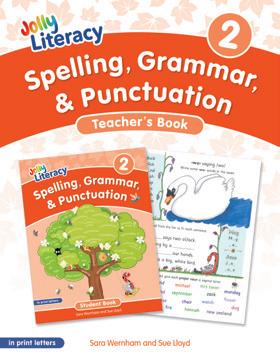
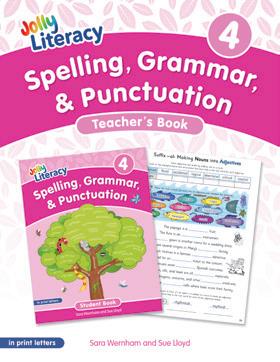
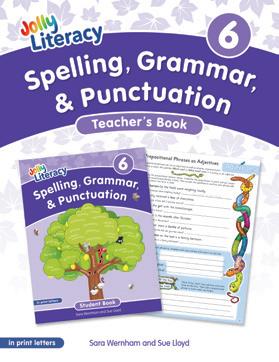
Each Teacher’s Book in the series
• Is a comprehensive resource for teaching spelling, grammar, and punctuation with the Student Books.
• Offers a wealth of practical advice and step-bystep lesson plans for the academic year.
• Systematically reinforces the learning so that no one is left behind.
• Introduces complex grammatical concepts in an engaging and child-friendly way.
• Teaches new spelling patterns, supports a greater understanding of sentence structure, expands vocabulary and comprehension, and cultivates dictionary and thesaurus skills.
To see the full range of Jolly Literacy products, visit our website at www.jollylearning.com
© Sara Wernham and Sue Lloyd 2025 (text)
© Jolly Learning 2025 (illustrations) Illustrated by Laia Capdevila 2025
82 Winter Sport Lane, Williston, VT 05495, USA Tel: +1-800-488-2665 Fax: +1-802-864-7626
77 Hornbeam Road, Buckhurst Hill, Essex, IG9 6JX, UK Tel: +44 20 8501 0405 Printed in the UK. All rights reserved. www.jollylearning.com info@jollylearning.co.uk
ISBN 978-1-83582-219-7
Reference: JL2197
American English Edition
